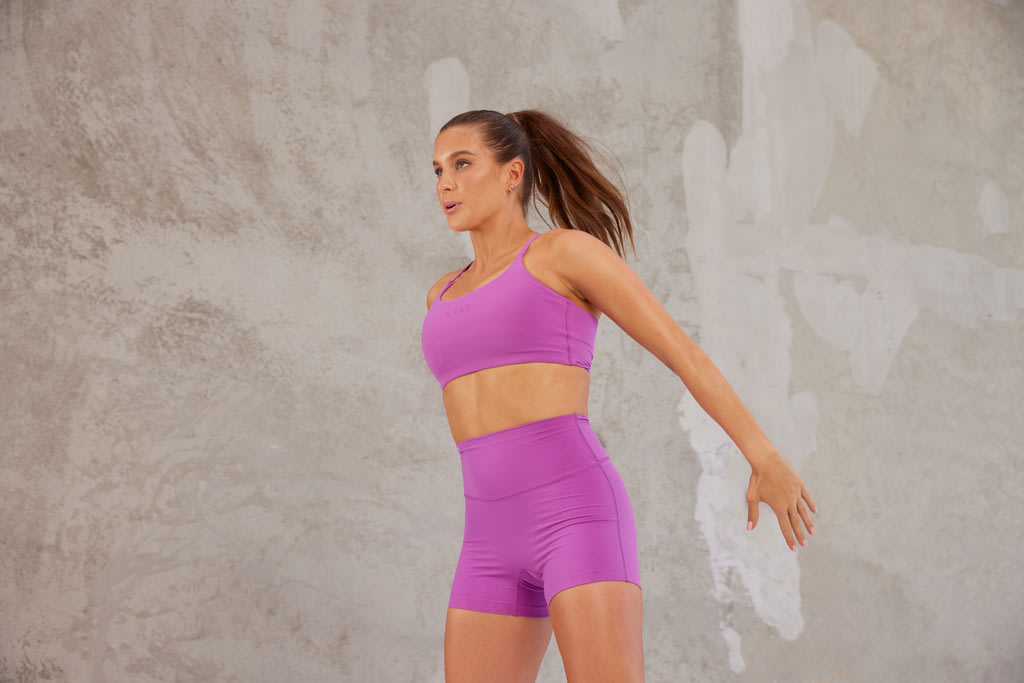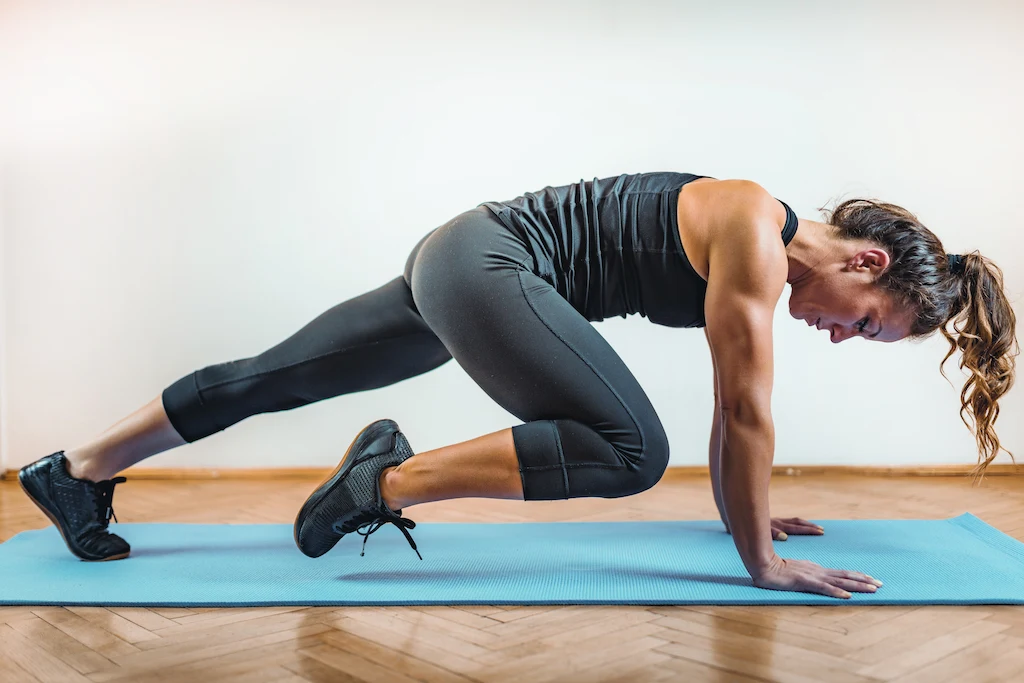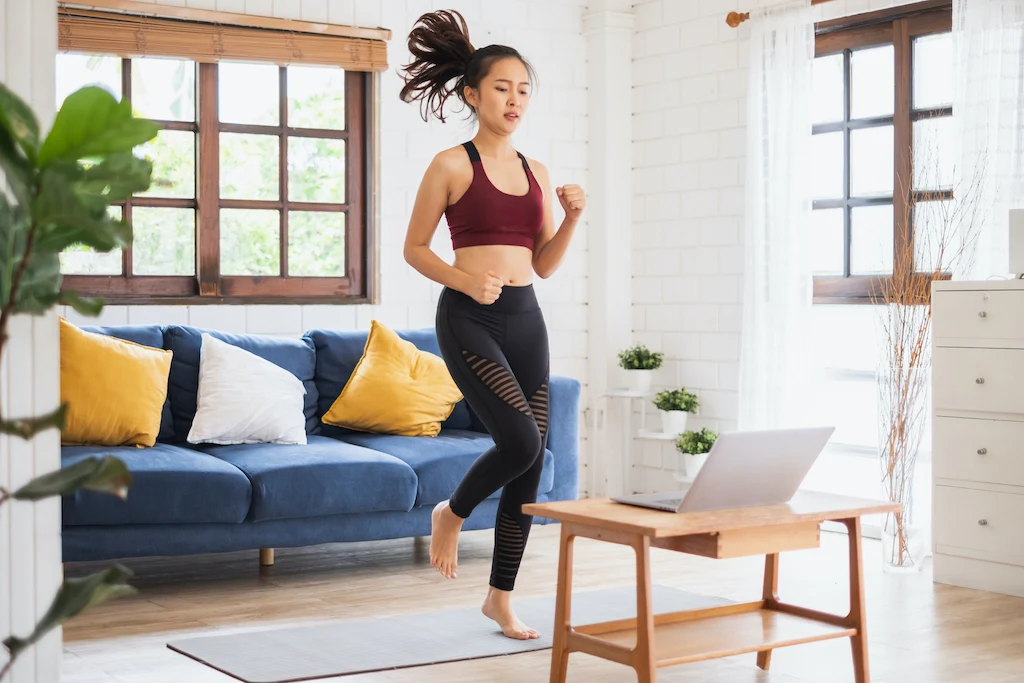Your Guide To Doing HIIT Workouts At Home

June 9, 2020 - Updated December 28, 2023

Designed to achieve maximum results through short bursts of intense effort with or without equipment, high-intensity interval training (HIIT) is an incredibly popular way to exercise at home and a training style many women in the Sweat Community LOVE.
If you’re looking for a style of training you can do at home that can get you fit no matter what level of equipment you have access to, HIIT workouts could be exactly what you’re looking for.
HIIT workouts can improve your fitness and your overall strength without having to find the time for lengthy sessions while delivering an amazing endorphin rush and all the other benefits of exercising. In this article, we’ll break down how to get started with HIIT at home.
What is HIIT?
HIIT stands for high-intensity interval training. It involves working hard for short, intense intervals, and having small breaks in between to catch your breath. HIIT is designed to get your heart rate high with a challenging full-body workout!
HIIT workouts usually last between 10-30 minutes, and the training intervals typically range between 20-40 seconds. The aim is to work as hard as you can during the workout intervals - you should find you really need those short breaks to recover.
Some of the most common HIIT workout formats are:
Tabata: Work hard for 20 seconds, followed by 10 seconds of rest. A traditional Tabata workout only lasts for eight rounds or four minutes in total, but it’s common for workouts to include much longer Tabata sessions.
EMOM: This stands for ‘every minute on the minute’, and refers to a workout where you’ll be performing a set number of repetitions within the minute, and if you complete them within this time frame, the remaining time is your short rest period. As soon as you hit the 60-second mark, you start your next set!
AMRAP: This stands for ‘as many reps as possible’, and means pushing yourself to complete as many reps of an exercise as you can within a given time frame.
Exercises in a HIIT workout typically have a cardio element to increase your heart rate. These can be bodyweight movements or use free weights such as dumbbells, kettlebells or a medicine ball to challenge your muscles even more.

Benefits of doing HIIT workouts at home
From time efficiency to convenience, there are many benefits to doing HIIT workouts at home.
Combine strength and cardio in one
HIIT tends to include elements of both strength training and cardio, making for an efficient and well-rounded home workout with a huge range of health benefits.
HIIT is quick and efficient
One of the best things about HIIT is the workouts will typically take you less than 30 minutes. If you’re trying to squeeze a great home workout in on your lunch break, when you’re short on time, or at unusual hours of the night as a shift worker, this makes HIIT a great option. Where you might have to plan your day more carefully around a 45-minute strength training session, quick HIIT workouts are far easier to fit in!
Convenient and low-maintenance
Many workouts require little to no equipment so from the most basic setup to the most well-equipped home gym - you can make it work.
When equipment is required, it’s usually free weights and there are plenty of household items you can substitute such as large bottles filled with water or sand as a substitute for dumbbells, or a towel instead of an exercise mat.
You don’t need much space
If you’ve got enough space for a yoga mat, you’ve got enough space for a HIIT workout! Whether you prefer to work out in your bedroom, living room, office, backyard or balcony, simply roll out your mat and get ready to HIIT it.
Improve your cardiovascular fitness
If you’re doing a HIIT workout at home correctly, you’ll be very out of breath and crying out for those short rest periods. Although HIIT workouts feel tough (they’re high intensity for a reason), they’re amazing when it comes to improving your cardio fitness and VO2 max fast.

What equipment do you need to do HIIT at home?
While there are no essential pieces of home gym equipment you’ll need, there are some items that can help to add some variety and challenge during your at-home HIIT sessions.
Yoga mat
A yoga mat won’t necessarily help to level up your strength or fitness, but having a protective layer under your feet can help to protect your joints when completing high-impact exercises, prevent you from slipping on the floor, and provide a nice clean surface. This versatile piece of at-home equipment also doubles as a comfortable surface for post-workout stretching and foam rolling.
Skipping rope
A skipping rope can be great to have on hand if you’re following one of our head trainer Kayla Itsines’ high-intensity programs. If you’re creating your own HIIT workouts, skipping can also be a fantastic exercise for short bursts of cardio or a 5-minute warm-up.
Light dumbbells or kettlebells
While there are plenty of HIIT workouts that don’t include weights, having a set or two of light dumbbells or kettlebells can allow you to add resistance to your workouts once you become more confident with your form and want to get stronger. If you don’t have much space available to store equipment, an adjustable set can give you the freedom to change your weights whenever you need.
You can often use dumbbells in place of a weight plate or medicine ball, too.
Resistance bands
Resistance bands are affordable, take up minimal space, and are great for increasing the difficulty of your HIIT workouts. When it comes to choosing a band, they differ in length, material and stretch, so consider what exercises you want to use them for before making up your mind!
If you want to use a band around your thighs during squat jumps, you’d go for a short looped band, but for seated rows with a band around your feet, you’d use a long unlooped band.

How to do a HIIT workout at home
Now you know all about this training style, the workout formats, benefits and equipment, here are our final top tips to set yourself up for your best Sweat session.
1. Find your space
Find a space in your home you can use to work out. You’ll want at least enough space for a yoga mat, to ensure there’s nothing you might hit or knock over around you, a high enough ceiling if you plan on jumping or using a skipping rope, and good ventilation to keep you cool.
2. Consider your timing
Whether you’re choosing a workout from the Sweat app or creating your own, it pays to know how long you plan on working out for. If you’ve got less than 20 minutes to Sweat, there are plenty of Express HIIT workouts in the On Demand section of the app!
For absolute beginners, we recommend starting with a short 10-15 minute HIIT session to build your fitness and get comfortable with the intensity. You can also reduce the working intervals and increase the rest periods if you need. As your fitness and confidence improve, increase the length of your working intervals, decrease the rest, and have a go at longer workouts.
3. Choose your exercises
If you’re designing your own workout, you can pick and choose whatever exercises you want to suit your space, equipment, mobility and fitness level. You might start with bodyweight exercises such as lunges, squats, mountain climbers or burpees.
If you’re following a workout in the Sweat app, remember to check your settings to ensure your equipment profile matches what you have at home. This will automatically substitute exercises for you. If an exercise appears in your workout that you’d like to swap out, you can use the exercise substitution feature to do so in a flash!
4. Never skip your warm-up
This advice applies to any workout, but HIIT especially. Because HIIT sessions are intense, it’s important to gradually increase your heart rate and body temperature before you start, and prepare your muscles and joints for the movements to come.
Getting started with HIIT workouts
If you're a beginner to working out, doing HIIT, or working out at home, why not try a free Sweat workout? This low-impact beginner workout is a great place to start, or if you’ve got a set of dumbbells and want more of a challenge, try this one!
HIIT is a fun, challenging way to work out and can offer some serious benefits, but if it’s not quite right for you or your home setup, there are many different training styles you can choose from!

A more empowered you starts with Sweat, and our editorial team is here to bring you the latest fitness tips, trainer recommendations, wellbeing news, nutritional advice, nourishing recipes and free workouts.
* Disclaimer: This blog post is not intended to replace the advice of a medical professional. The above information should not be used to diagnose, treat, or prevent any disease or medical condition. Please consult your doctor before making any changes to your diet, sleep methods, daily activity, or fitness routine. Sweat assumes no responsibility for any personal injury or damage sustained by any recommendations, opinions, or advice given in this article.
Fitness